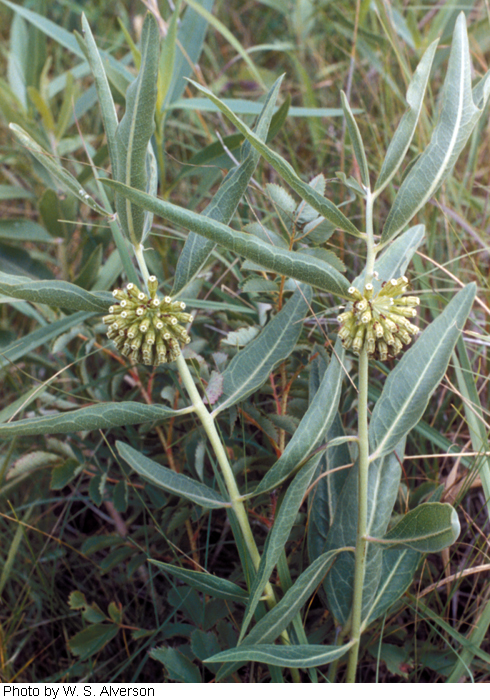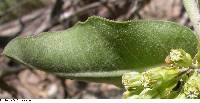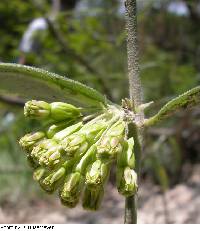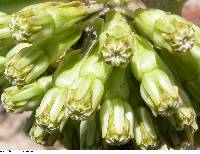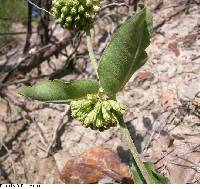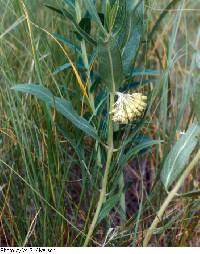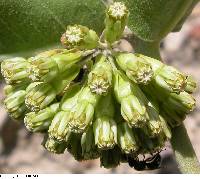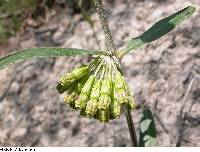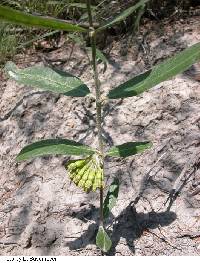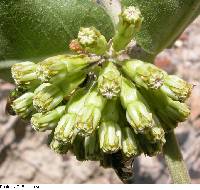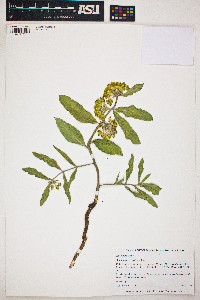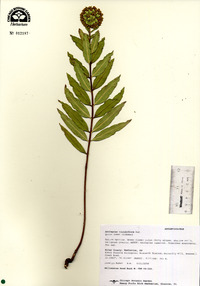|
Family: Apocynaceae
green comet milkweed
[ Acerates viridiflora (Raf.) Eat., moreAcerates viridiflora var. ivesii Britton, Acerates viridiflora var. linearis A. Gray, Asclepias viridiflora var. lanceolata (Ives) Torr., Asclepias viridiflora var. linearis (A.Gray) Fernald] |
Plant: perennial herb; stems erect or ascending, typically unbranched, 10-50 cm tall; milky sap Leaves: opposite to irregularly alternate, the petioles 2-7 mm long, the blades narrowly lanceolate to linear, 5-14 cm long, 2-17 mm broad, attenuate to an acute apex, acute to obtuse at the base INFLORESCENCE: UMBELS lateral at 1 to few of the upper nodes, 3-4 cm broad, the peduncles 0.4-1.5 cm long Flowers: small; calyx lobes 3-4 mm long; corolla greenish, the lobes 5-7 mm long; hoods greenish yellow, erect and appressed to the anthers, ellipsoid-oblong, obtuse-rounded at the top, 2.8-3.8 mm long, 1-1.3 mm broad in the middle, ca. 1 mm shorter than the gynostegium, the horns absent; anther wings 2-2.6 mm along their entire length, the upper portion 1.4-1.7 mm long; corpusculum 0.3-0.4 mm long, the pollinia conspicuously long attenuate above, 1.6-2 mm long Fruit: FOLLICLES erect on deflexed pedicels, 7-15 cm long Misc: Open pine forests; apparently rare; 1600-2150 m (5300-7000 ft); May-Aug REFERENCES: Sundell, Eric. 1994. Asclepiadaceae. J. Ariz. - Nev. Acad. Sci. Volume 27, 169-187. Erect to prostrate, 3-8 dm, thinly hairy; lvs lanceolate to linear or broadly oblong, elliptic, or ovate-oblong, scabrous on the margin, thinly hairy beneath; umbels lateral, densely fld, sessile or on peduncles to 2 cm; cor pale green, its lobes 6-8 mm; hoods narrowly elliptic-oblong, 4-5.5 mm long, appressed to the gynostegium, the base adjacent to the cor, the obtuse or subacute summit reaching well beyond the salient angle of the anther-wings or even to the top of the gynostegium; horns none. Dry upland woods, prairies, and barrens, especially in sandy soil; Conn. and s. N.Y. to Mich. and Man., s. to Ga., Ariz., and n. Mex., commoner westward. July, Aug. (Acerates v.)
Gleason, Henry A. & Cronquist, Arthur J. 1991. Manual of vascular plants of northeastern United States and adjacent Canada. lxxv + 910 pp.
©The New York Botanical Garden. All rights reserved. Used by permission. Sundell 1993, Woodson 1954, Martin and Hutchins 1980, Nabhan et al 2015 Duration: Perennial Nativity: Native Lifeform: Forb/Herb General: Erect to ascending perennial with stout stems 10-60 cm tall, simple, glabrate to tomentose. Leaves: Opposite to irregularly alternate, on petioles 2-7 mm long, blades lanceolate to oblong-lanceolate or linear, 5-14 cm long, 2-17 mm across, pointed at apex, base obtuse to acute. Flowers: Lateral to axillary umbels ranging from one to many at upper nodes, 3-4 cm across, on peduncles less than 1.5 cm long, the flowers moderately large with reflexed calyx lobes 3-4 mm long, the corolla greenish white, the lobes 5-7 mm long, the hoods 2-4 mm long, yellowish green to purple tinged, narrowly oblong and erect, horns absent. Fruits: Puberulent follicle 5-15 cm long, erect on deflexed pedicel, 1.5-2 cm wide, finely puberulent to glabrate. Ecology: Found in open pine forests, plains and praries, and on hillsides in rocky or sandy soils from 5,000-7,000 ft (1524-2134 m), flowers May-August. Distribution: Ranges across the US from Canada to Mexico, from the east coast to Montana and Arizona and south to Coahuila. Notes: Some indication that this species might prefer limestone soils. Average 78,110 seeds per pound. Ethnobotany: Poultice of chewed roots applied to swellings, rashes, sore eyes, the roots were chewed for sore throats, and were used to spice soups. Etymology: Asclepias is named for the Greek god of healing Asklepios, while viridiflora means with green flowers. Synonyms: Acerates viridiflora, Acerates viridiflora var. ivesii, Acerates viridiflora var. linearis, Asclepias viridiflora var. lanceolata, Asclepias viridiflora var. linearis Editor: SBuckley 2011, 2014 |

